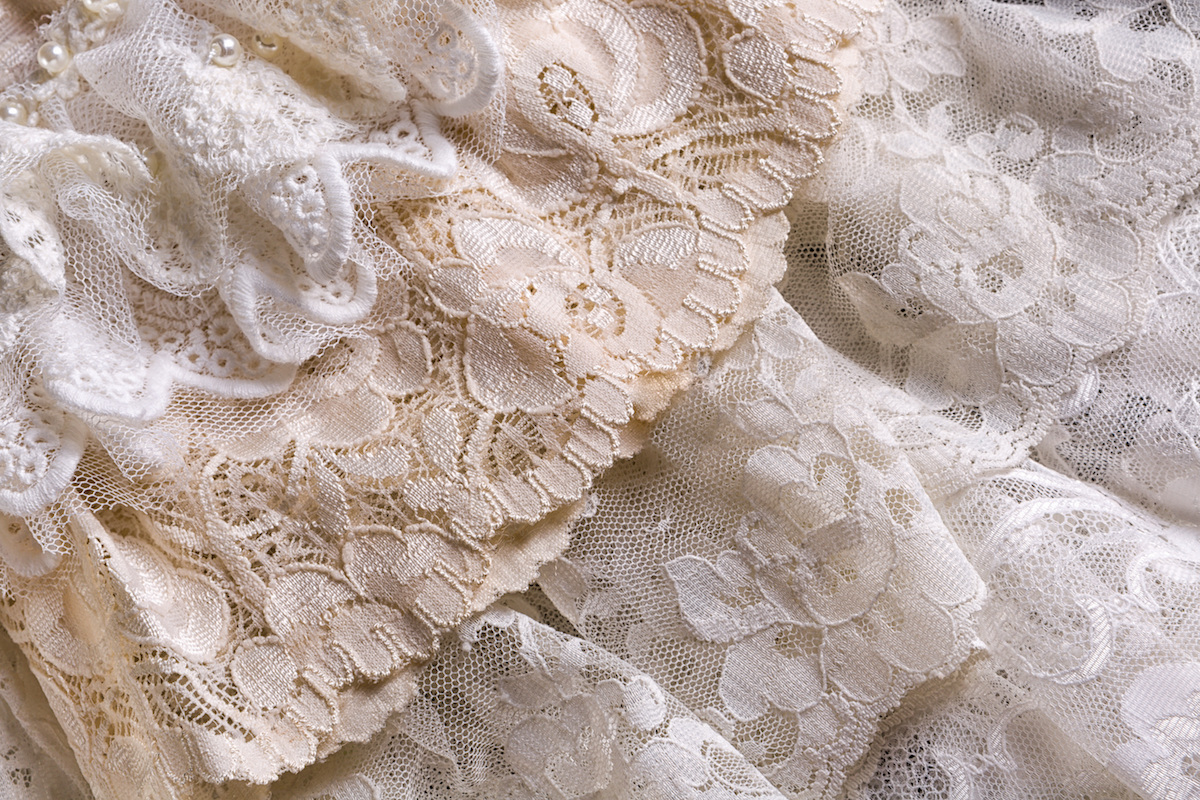Wedding Gown Fabrics 101

Closeup of white beige and ivory vintage lace fabrics via Shutterstock
In a sea of meringue poufs and lace-fitted bodices, it can be hard to understand which fabric to choose for your gown, never mind the cut itself.
Here, Alix Childs, owner and creative director at Beacon Hill’s bridal boutique Ceremony Boston, breaks down some of the most popular spring/summer fabrics. From how they drape to their style vibe, she’s got your covered.
Silk: This is probably one of the most common wedding gown materials because there are just so many types. “I love the soft, buttery, and lustrous silks with a beautiful drape the most because they bring out that touch of old Hollywood glam,” says Childs. This fabric tends to work best when it’s unembellished and simply adorned in a vintage-inspired cut or classic sheath silhouette with an elegant drape. This way the focus stays on the cut of the gown and the bride’s figure. “Silk can be a tricky material to wear for someone who isn’t comfortable with showing off their curves or someone who likes a more structured fit,” warns Childs. Silky dresses have a red carpet feel when dressed up for a black-tie celebration, but their sleek silhouettes can also be accessorized to work in a more casual setting like a barn or beach.
Crepe: Technically a type of silk, crepe shares many of silk’s properties, but boasts a matte finish because of how the fibers are twisted and woven during fabrication. “Crepe is a great choice for brides who want the same sleek, elegant look of glossy silks but needs more coverage,” explains Childs. “It tends to be a bit heavier and, because of the matte finish, a little more forgiving.” The nature of the crepe also suits it for less formal celebrations. “I find it’s a big hit for outdoor, daytime weddings where brides want something light and elegant but also easy and graceful,” she continues.
Lace: Especially in head-to-toe styles, Childs considers lace feminine, romantic, and soft. Depending on pattern and type, it can go from being very classic and quite traditional to very vintage-inspired. “A lot of brides like lace for outdoor, rustic celebrations as it’s extremely wearable but still feels quite special,” she says. Lace works nicely in sleek, sheath, mermaid, or trumpet silhouettes because it allows the bride to wear something more form-fitting while the lace patterning provides more “coverage” than the unembellished silks and crepes. It can also camouflage more structured elements like boning and internal corsets. “At the moment I’m really loving the heavier, more densely woven laces like Battenburgs that lend an heirloom quality to the bridal look by evoking the feel of vintage textiles,” she adds. Lace also works well in a gown with sleeves as the very sheer and delicate laces don’t feel too overwhelming in this all over style, yet still allow for arm movement.
Tulle: Generally when you think of tulle in wedding gowns, it’s in layers upon layers of the material in the skirt of a ball gown. “This is the go-to for brides looking for a more voluminous, classic wedding dress from the waist down, but who still want something light, airy and wearable,” says Childs. Tulle can easily evoke the Cinderella bridal look (especially when paired with a strapless bodice), but can also take on a more refined and modern look with the right trimming and accessories. Childs suggests tulle ball gowns or A-line shapes if you’re looking to accentuate your waistline, since designers generally pair fuller bottoms with structured, fitted bodices in silk or lace. This play on proportion can be extremely flattering for a variety of body types. But petite brides be warned. Very big tulle skirts can be overwhelming and swallow you whole, so be careful in your choice.
What stories do you want to see in Boston Weddings? Send us tips at weddings@bostonmagazine.com.
Getting married? Start and end your wedding planning journey with Boston Weddings' guide to the best wedding vendors in the city.


